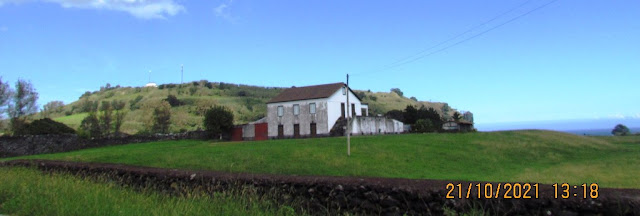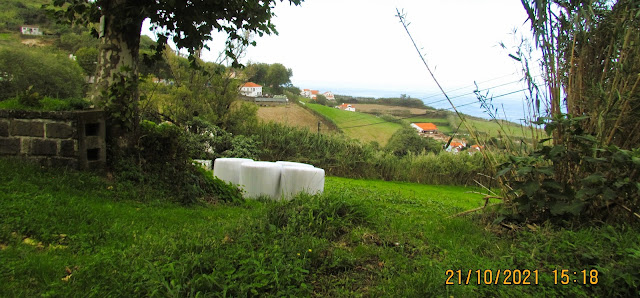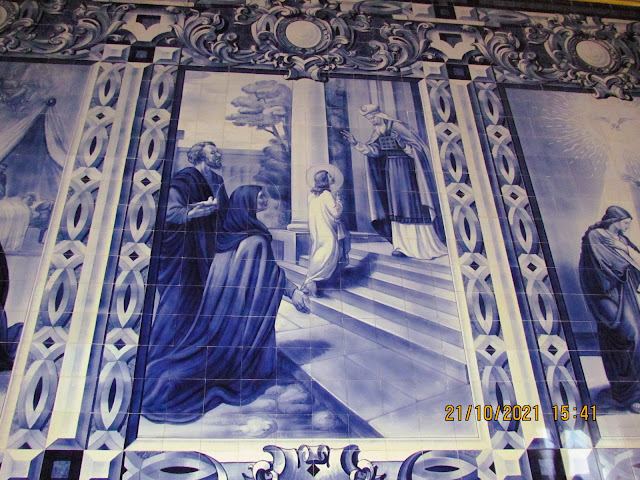CAPELAS
(Parish of Ponta Delgada Municipality)
37°50′5″N 25°41′51″W
Capelas is a Portuguese parish in the municipality of Ponta Delgada, Azores, with 16.84 km² of area and 3981 inhabitants (2021 census). Its population density is 236.4 hab./km².
It is located at a latitude 37.833 (37°50') North and a longitude 25.6833 (25°41') West, with an altitude of 60 meters. The main activity is agriculture and the production of tea.
History
The Church of Our Lady of the Presentation was instituted as a parish on Feb. 12, 1592, by regia letter from Philip II (I of Portugal), at the request of the then Bishop of Angra, D. Manuel de Gouveia. The matrix church (16th century) boasted the title of 'Matrish-Prial'.
It was elevated the village and headquarters by the Charter of Bill of July 23, 1839. The municipality consisted of the parishes of Brittany, Chapels, Fenals of Light, St. Anthony and St. Vincent Ferreira. He had, in 1849, 9,026 inhabitants.
However, the county was ephemeral, never having taken in fullness the respective functions. It was extinct in 1855, returning its territory to the council of Dyta Delgada. Never losing the title of Villa but falling into oblivion this was reinforced the villa category on June 24, 2003. Populations of neighboring Chapels and parishes claim the county restoration.
Capelas was an important hub of hang hunting, functioning in its small harbor, in the first half of the 20th century, a whaling frame. Near the harbor (Pews) an oil and sperm flour factory was installed, when this activity ended, it was ruined and was later demolished, leaving only the main chimney.
Adjacent Parishes
Santo António,
Feteiras,
Relva,
Arrifes,
Covoada,
São Vicente Ferreira.
👇👇👇👇
AJUDA DA BRETANHA
(Parish of Ponta Delgada Municipality)
37.89913, -25.75474
Ajuda da Bretanha is a northern civil parish in Ponta Delgada Municipality, on the São Miguel Island, Azores. The population in 2011 was 661, in an area of 7.09 km2. It contains the localities Ajuda da Bretanha, Amoreira, and Lombinha.
History
Until 1527, Bretanha was part of a much larger parish Capelas.
The parochial church is dedicated to Nossa Senhora da Ajuda. Constructed at the end of the 18th Century (1770 specifically), it was built on the site of an older church constructed of straw, two centuries before. It is a church designed in the Baroque style, that includes a symmetrical front facade, and bell tower; its interior consists of an ample sacristy, with a baptismal fountain constructed of pumice. An ancient image of Nossa Senhora da Ajuda, holding the Christ Child, has survived many years and is sheltered in this church. Further, the original organ in the church was produced by Silvestre Serrão, organist at the Church of Santa Maria de Belém (Jerónimos Monastery), in Lisbon, who would construct various organs for churches in the Azores, such as in Santo António and Capelas, in addition to the Churches of São Sebastião and São Pedro in Ponta Delgada.
Geography
The parish borders the crater of Sete Cidades to the south and the Atlantic Ocean to the north, falls between Mosteiros and Pilar da Bretanha; coastal cliffs dominate the ocean border while sloping towards the crater (an area that includes mostly forested tracts and pasture-lands).
On its creation, Ajuda da Bretanha was defined in the following terms: its northern border included the maritime coast; its southern frontier the Cumeeiras das Sete Cidades; to the east along the border with Remédios; and to the west, along a line that begins at the coast and follows coincident with the waters of the Grota da Lomba Grande, to the south, following the Grota da Lomba Grande and the service access of the Caminho da Lomba Grande, following this road east until it intersects the Lomba Grande once more. Continuing south, the frontier accompanies the same margin and Caminho da Lomba Grande until the Cumeeiras das Sete Cidades.
Economy
The parish economy is driven by agriculture and dairy-raising, although forestry does occur in the interior. In addition, a small commercial and tourist economy does exist in this community, although the economy is more subsistence-oriented than the remaining parishes in Ponta Delgada.
Architecture
Civic
Windmill of Pico Vermelho (Portuguese: Moinho de vento no Lugar do Pico Vermelho), re-inaugurated on 13 August 2013, the windmill was reopened to the public after a period of remodeling, as part of a local tourist initiative for the civil parish, the windmill was an important part of the agricultural history of the community.
Religious
Church of Nossa Senhora da Ajuda (Portuguese: Igreja Paroquial de Nossa Senhora da Ajuda da Bretanha/Igreja de Nossa Senhora da Ajuda), little is known of the history of this temple, except what could be gathered from its clergy; its first vicar was Afonso de Sampaio (began his service in 1527), and until 1640/1646 the church was dedicated to Nossa Senhora da Natividade (Our Lady of the Nativity). Around 1737, the clergy that occupied this temple spent considerable funds to decorate the church.
Culture
Festivities
During August, Ajuda celebrates the feast of Nossa Senhora dos Anjos, with its principal religious ceremonies on August 15. From the parochial church, apart from celebrating masses in Her honor, a typical religious procession winds through the roads in the parish, accompanied by the traditional philharmonic bands.
In addition, the traditional festivals from the Divine Holy Spirit are celebrated annually from the beginning of May to the end of June in the traditional impérios of the parish.
At the beginning of the year, the feast day of Saint Anthony the Great is also celebrated on January 17.
💝💝💝💝💝
INDEX
Search in São Miguel Island & Azores
😍😍😍😍 - AZORES ISLANDS
💟💟💟 - São Miguel Island
🔟🔟🔟🔟 - Must-see attractions
💙💙💙💙 - Municipalities
💙💙 - Parishes
Municipalities and Parishes
Sao Miguel Island
AZORES ISLANDS
🙆🙆🙆🙆🙆🙆🙆🙆🙆🙆
🙆🙆🙆🙆🙆🙆🙆🙆🙆🙆
Return to the Index
INDEX
Search in São Miguel Island & Azores
😍😍😍😍 - AZORES ISLANDS
💟💟💟 - São Miguel Island
🔟🔟🔟🔟 - Must-see attractions
💙💙💙💙 - Municipalities
💙💙 - Parishes
Municipalities and Parishes
Sao Miguel Island
AZORES ISLANDS
Return to mainland Portugal and
to the Azores and Madeira islands








































































































































































































































































No comments:
Post a Comment